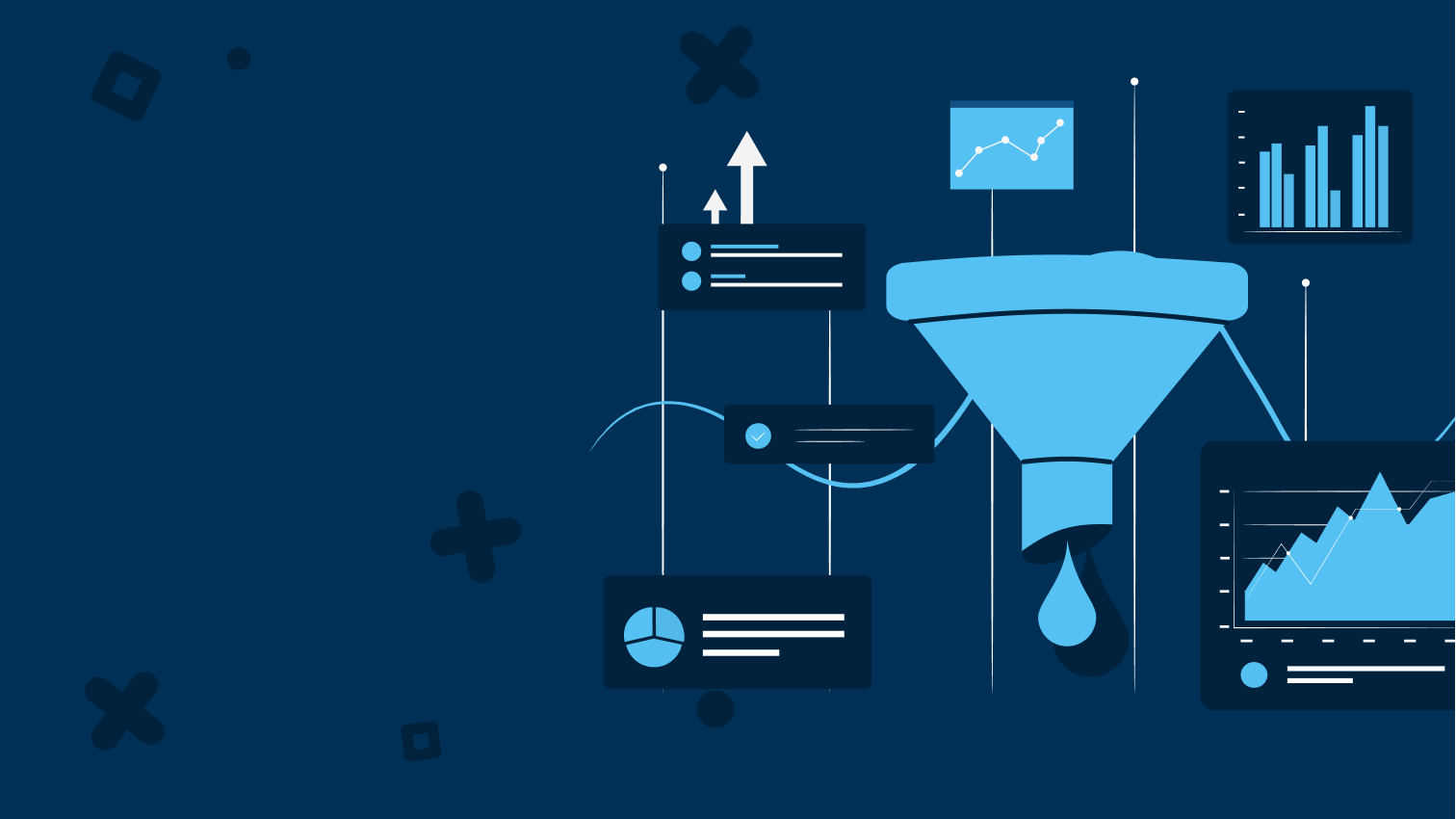
Leveraging Customer Data to Build a High Converting Marketing Funnel
Leveraging Customer Data to Build a High Converting Marketing Funnel
You come up with a winning marketing strategy and implement and execute it with absolute perfection. But still, people just don’t buy. Every marketing team has found themselves in a situation where they do everything right, but somehow things don’t work out.
If you’re one of them, you probably have a broken sales funnel. Sales funnel isn’t another fancy sales concept that every brand has to hop on.
Almost every company has a so-called sales funnel, but it’s nothing more than a blog page leading to an email sign-up form which then triggers a series of automated emails.
Creating an effective sales funnel is all about knowing your customers – their behavior, challenges, preferences, and interests. And knowing your customers boils down to collecting and analyzing customer data.
Here’s an in-depth guide to how you can leverage customer data to build a high-converting marketing funnel that guarantees sales and revenue.
Importance of Customer Data to Improve Marketing Outcomes
Data plays a decisive role in every decision and move made by your marketing team. It lays the foundation of all actions taken by your marketing team and the organization as a whole.
In this digital era, the amount of data available to businesses is only going to increase. Almost 2.5 quintillion bytes of data are generated every day, and this number is only going to increase.
Regardless of your industry, target market, and the type of products/services you offer, collecting customer data is essential to improve not only marketing efforts but every aspect of the business.
But the importance of data increases tenfold when it comes to marketing. Since marketing is a customer-centric activity, the more you know about your consumers, the better decisions you can make.
Marketing has changed significantly over the years. In addition to amplifying your products and service quality, you also need to understand your customers, their pain points, what motivates them, etc. Figuring out your customers’ on-boarding intent and decision-making process is crucial.
Customer data collection makes framing a marketing strategy easier in the following ways:
- Improves customer database
- Helps conceptualize better products/services
- Strengthens your marketing campaign strategies
- Helps you formulate the right pricing strategy
- Assists with accurate data collection to streamline personalization
- Promotes communication and enhances customer satisfaction
Now that you know the importance of collecting customer data, let’s talk about what data you should collect and analyze.
- Net promoter score
- Updated contact information
- User experience data
- Purchase decision hierarchy
- Initial touchpoints
- Reason for churn
- Buying behavior
- Social media following and engagement
- Decision-making power
It’s also important to measure the right marketing metrics. Here are the key marketing KPIs you should track.
- Marketing-qualified and sales-qualified leads
- Return on marketing investment (RoMI)
- Total website traffic
- Referral traffic
- Customer acquisition cost (CAQ)
- Cost per lead
- Customer retention rate
- Subscriber growth rate
- Customer lifetime value
- Testimonials
Of course, every business is unique and has different requirements. Metrics that are critical for one company may not be necessary for the other. It’s essential to understand your objectives well and determine metrics that align with them.
Once you have the desired customer data and marketing KPIs in place, you can leverage them to devise a marketing roadmap and build a high-converting sales funnel.
What Is a Marketing Roadmap?
A marketing strategy roadmap or simply a marketing roadmap enables you to put all your marketing plans, goals, and tactics on paper. Marketing in this age can be chaotic. With new channels emerging and customer expectations changing, marketing teams have to stay agile and shift between priorities to meet their objectives.
With a marketing roadmap in place, you can organize the chaos and clearly define what you want to achieve. You can share the roadmap with your team and key stakeholders to bring everyone on the same page.
Here’s why creating a marketing roadmap should be the first step of your marketing strategy.
- Alignment: Bring all team members and stakeholders on the same page
- Coordination: Ensure seamless coordination between teams and departments
- Visibility: Achieve transparency and keep the entire organization updated with the upcoming marketing campaigns
- Impact: Track and measure the effectiveness of a marketing campaign
- Communication: Communicate plans and strategies with internal teams and departments for better collaboration
We’ll come to creating a marketing roadmap in a while, but let’s first discuss the key elements every marketing roadmap should contain.
- Timeframe: Dates and timelines on which your activities will be scheduled and completed
- Goals: Measurable, time-bound objectives and the criteria of success
- Initiatives: Themes of work and big efforts that highlight the key efforts required to achieve your goals
- Schedules: Plan and visualize major campaigns, events, and programs
- Activities: Highlight marketing activities, such as press releases, email campaigns, and landing pages
- Statuses: Progress of your goals, initiatives, plans, and activities
Finally, let’s look at a step-by-step process of developing a marketing strategy roadmap.
1. Identify Your Audience: Determine your target audience and create accurate buyer personas. Segment your prospective customers and decide how you’re going to position yourself in front of them.
2. Set Your Goals: The next step is to set clear objectives. Please note that the goals that you’ll set here aren’t your marketing objectives but the aim of creating the roadmap. It could be convincing stakeholders, seeking additional marketing budget, etc.
3. Integrate Your Roadmap in Goals: Include all the important elements of your marketing strategy in the roadmap. These include KPIs, OKRs, and other metrics that you’ll be tracking.
4. Collaborate with Stakeholders: An essential aspect of creating a marketing roadmap is to bring important stakeholders on board. Determine which stakeholders you want to incorporate in your marketing strategy.
5. Visualize Your Information: Finally, figure out how you’ll visualize your marketing roadmap. Would it be in a spreadsheet or a Trello board?
How to Build a High-Converting Sales Funnel?
A purchase (or sales funnel) is a consumer-focused marketing model that maps and illustrates a customer’s journey. Your sales funnel can make or break your marketing campaign, and therefore, it’s one of the most critical aspects of any marketing strategy.
If you’re generating leads but not converting them into customers, you probably don’t have a good sales funnel. Research from Salesforce shows that 68% of companies don’t measure their sales funnel. The same survey also shows that 79% of marketing leads are never converted. Without an effective sales funnel, converting leads into sales is nearly impossible.
If you want to develop a high-converting sales funnel but aren’t sure where to start, here’s a step-by-step guide to follow.
Understand the Market and Audience
The first step of developing any marketing model or strategy is to get a comprehensive view of the marketing landscape. This includes understanding your target market and audience. In this age of marketing relevance, if you want to target everyone, you’ll end up converting no one.
Gone are the days when businesses could run generic campaigns targeting everyone and expect consumers interested in their products/services to come to them. Now, marketing teams need to define highly specific audiences and focus their marketing messages on them. This approach is not only affordable but also more effective and efficient.
If you’re a new business, you can define your market by examining your competitors. You should see who their current customers are and who they’re targeting. You don’t have to go after the same customers, but it can be a good starting point. Your target market will also depend on the product or service you offer. For example, if you provide CRM software solutions, your prospects will naturally be small-midsize business owners looking to optimize their customer database.
Once you’ve determined your target market, delve deeper and create accurate buyer personas. Persona profiles represent hypothetical customers that resemble your ideal customers. Define the following areas to create a perfect buyer persona.
- Age
- Gender
- Location
- Education Level
- Income level
- Occupation
- Family status
- Ethnic background
- Challenges/pain points
Please note that not all of these metrics will be important to you. For example, if you offer CRM software, your buyer persona could look something like:
- Age: 30-45 years
- Occupation: Business owner
- Location: USA/UK/Australia (if relevant)
- Income level: $80,000-150,000
- Challenges/pain points: Managing customer database; leveraging customer data to drive meaningful relationships and customer loyalty
In this case, demographics like gender, family status, ethnic background, etc., won’t matter. On the other hand, if you’re a fashion brand, gender and location play a pivotal role in your personas.
Once you have developed buyer personas, you can come up with advertising campaigns and content marketing plans to increase your outreach and reach potential customers.
Devise a Top-Level Strategy with Short-Term Goals
If you’ve created a marketing roadmap, as discussed before, you probably already have a marketing strategy with short-term objectives ready. If not, here’s a quick blueprint.
Start by looking at the bigger picture. For example, if you want to increase revenue, the long-term goal can be to achieve 15% higher sales than the previous quarter. Once the bigger picture is clear, you can break it down into smaller, trackable, and actionable objectives, also known as SMART goals.
Driving more sales is the key to increasing revenue. To drive more sales, you can try to improve outreach and reach more potential customers. Here are some proven ways to boost your outreach.
- Pick the right channel of communication to target your audience
- Leverage social media
- Automate your outreach with marketing automation tools
- Collect email addresses and send personalized emails
- Humanize your brand and marketing message
You can break these goals into smaller components. Decide which social media networks you’ll use. If you’re a B2B company, LinkedIn could be a good place to get started. A marketing roadmap can be a useful tool in organizing all these elements.
If you want to leverage email, how do you plan to build an email list? A common practice is to put up a sign-up form on the website. You can also collect email addresses of brick-and-mortar customers using QR codes. You can put up a customized QR code inside your store, on your offline marketing materials, on product packaging, etc., and link it to the email sign-up form. Customers can scan the code from their smartphones and sign up for your email newsletter. QR Codes can be easily created and customized using a QR Code Generator and prove to be an extremely effective way of building up your email list from offline channels.
Create Goal-Oriented Campaigns
Once you’ve determined long-term and short-term goals, it’s time to create goal-oriented campaigns. The first step of setting up a marketing campaign is to outline the goals you want to achieve. Let’s say a short-term goal you want to achieve is to “generate more leads.”
Besides defining goals, it’s crucial to determine the target audience. The buyer personas you created in the first step will come in handy here. After deciding on the goals and audience, set a budget. If you’re advertising a product or service, setting a realistic budget is crucial. Even if your marketing campaign doesn’t involve advertising (organic content creation, email), calculate the costs associated with creating the campaign. It may include graphic design, copywriting, etc.
The next step is to select your media. Do you want to run a Google Ads campaign, social advertising campaign, email marketing campaign, or organic content publishing? Based on the media, develop your marketing content and the brand message you want to communicate.
Track the Right Metrics
Measuring the success of your marketing campaign can be tricky. The buyer’s journey is never a straight line. It’s often meandering and follows an unpredictable route. Therefore, it’s critical to track metrics across all touchpoints and awareness stages.
Let’s look at the key KPIs you should track at each stage of the customer journey.
Awareness Stage
- Impressions
- Reach
- Content views
- Cost per impressions
- SEO ranking (organic reach)
Consideration Stage
- Clicks
- Click-through rate (CTR)
- Cost per click (CPC)
- Engagement rate
Decision Stage
- Leads generated
- Sales
- Conversion rate
- Cost per lead (CPL)
- Cost of conversion
Retention Stage
- Net promoter score (NPS)
- Customer satisfaction
- Customer lifetime value (CLV)
- Issue requests
Advocacy Stage
- Referrals
Assess Performance and Identify Areas of Improvement
The final step in creating a high-converting funnel is to assess the performance, identify the areas of improvement, and make the necessary changes. No matter how much precision you put into your marketing campaign, you won’t be able to make it perfect. There will always be gaps, issues, and bottlenecks that you’ll need to address moving forward.
Therefore, it’s crucial to be agile and open to changes. If a strategy doesn’t work, don’t be afraid to adapt and improve. Also, be sure to use cutting-edge analytics tools so that you can get an in-depth insight into how your marketing campaigns are performing and which areas need to be improved.
Conclusion
Creating a sales funnel is arguably the most important part of your marketing strategy. Moreover, it isn’t just a step; it’s an ongoing process. As customer behavior and expectations keep on changing, you need to adapt your customer funnel to cater to their requirements. Marketers should always be asking themselves, “what can I do to be more relevant and live up to customers’ expectations?”
The views included in this article are entirely the work and thoughts of the author, and may not always reflect the views and opinions of Regex SEO.

